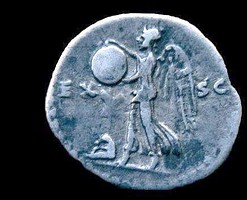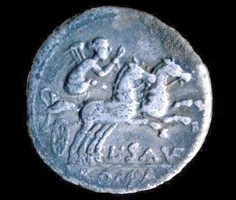 |
Victoria Victoria, the personification of victory, was originally a Latin goddess and protectress of fields and woods. Over time she was associated with Roman success in war and identified with the Greek goddess Nike. Winged Victory features as one of the most common reverse types on Roman coinage. This winged goddess made her appearance around 157 BC as a charioteer-type on reverse denarii: at the time Victory was frequently depicted as driving a biga (hence the coins were also known as bigati) and holding a whip, as shown on the reverse of a denarius of the moneyer L. Saufeius (left below). Depictions of her driving trigas and quadrigas soon followed as popular reverse types. In 79 BC, for instance, the moneyer C. Naevius Balbus struck a series of serrated denarii showing a winged Victory driving a triga, probably to commemorate Sulla's victories against Mithridates VI of Pontus. Other reverse types (i.e. quinarii of Cato) from the first century BC, often display a seated Victory holding a palm branch and patera with the legend VICTRIX in exergue. |
 |


